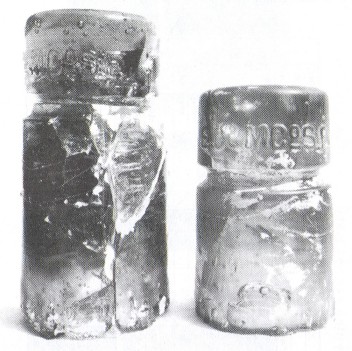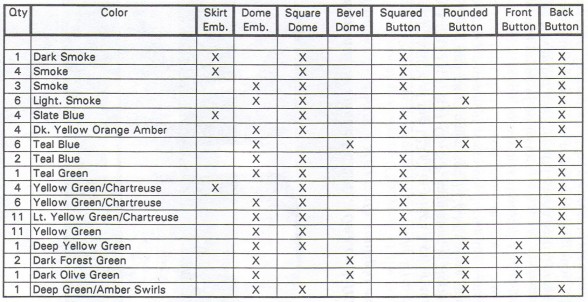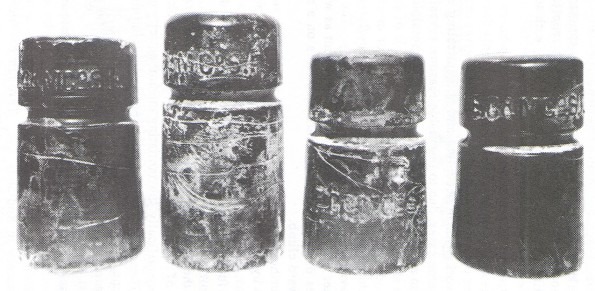X-Y-Z’s of the 1-2-3's
by Dwayne Anthony
Reprinted from "Crown Jewels of the Wire", June 1996, page 27
The November 1995 issue of Crown Jewels of the Wire contained an article
entitled “ABC's of the 123's” in which I reported on a recent discovery of
CD 123 E.C.&M. Co. S.F. insulators in Northern California. Both dome and
skirt embossed EC&M's were unearthed and salvaged by heavy equipment
operators during the summer of 1994. Almost one year later these jewels found
their way into the waiting hands of a collector, whom in turn has allocated a
good percentage of them to an elated group of collectors.


Two damaged light smoke EC&Ms. One on left has since
turned smoky SCA
with a six month sunlight exposure.
In the November 1995 report I gave a partial breakdown of the colors and
quantities obtained in relation to the grouping I personally viewed at that
time. I recently had the pleasure to view and photograph the remaining
EC&M's that prevented my previous listing from being accurate and complete.
I'm delighted to add three more colors--one deep yellow green, two bubbly forest
greens & one bubbly olive green--to the final list of insulators obtained in
this grouping. My previous estimated total of 85 colored EC&M's purchased in
this lot is now reduced to a final tally of 68.
The following chart contains a complete list of the EC&M's obtained in
the spring of 1995:


Four EC&M’s exhibiting various levels
of mineral deposits
(L to R) Smoke, Dark Forest Green, Smoke (skirt emb.), and
Dark Yellow Orange Amber.
For the sake of historical documentation, the above listed insulators are not
related to a separate, recently reported discovery of colored EC&M's from
the same geographical area. Upon personal viewing of approximately eight or so
specimens from this other group, it was noted that most seem to exhibit a fine
rippled or orange peel-like surface texture. However, I am told that others from
this same group reportedly do not. For the most part, the EC&M's reported in
the above chart exhibit a fairly smooth exterior surface, with some containing
random creases or folds.
It is extremely important, as the information becomes available, that each
new discovery is publicly and thoroughly documented--thus the purpose of this
and the prior report. This gives the hobby a foundation to work with in
accepting and authenticating each new discovery. In some cases, due to
justifiable reasons, revealing complete information as to exact location or
source is impossible. Unfortunately, such a shroud of mystery could, in the
minds of some, lead to skepticism and non acceptance of the story and/or
insulators described. Should this occur, the discoverer or reporter might be
expected to provide further evidence of authenticity. The need for providing
further proof is becoming more significant as we see the monetary values of most
scarce and rare insulators on a rapid and continuous upward climb.
What further steps can one take to provide further authentication? Attempts
by several collectors to procure a testing process for dating glass has, to my
knowledge, proven futile. In a personal attempt to add further authentication to
the EC&M's listed above, I submit the following:
Due to the original white deposits that were still present on a small number
of uncleaned EC&M's, I decided to look into the possibility of
scientifically substantiating the authenticity of the surface deposits. These
deposits, originally found in varying amounts on all the specimens, have since
been cleaned (primarily on the outer surface) from most by a method known as
tumbling (at each new owner's request).
After making several calls to soil, hazardous waste and chemical testing
laboratories, I finally submitted one of the uncleaned specimens--a dome
embossed smoke--for a surface test at a certified analytical laboratory in
Redlands, CA. Through chemical testing, coupled with the expertise of the
technicians involved, it was concluded that the surface staining is composed of
a non-organic, non-oil based material simply referred to as "mineral
salts", a naturally occurring ingredient in most soils. In addition to an
overall staining, the tested specimen had an area on the dome where the mineral
deposits had etched through the surface of the glass. Further conclusions stated
that these mineral salts would likely require a lengthy period of time
"eating" at the surface to create such a breakdown in the glass. The
technician that performed the actual testing stated that based on her experience
and the naturally aged appearance of the mineral stains, she would have no
problem accepting the insulator as authentic if she were “into this sort of
thing”.
So there you have it,
| 